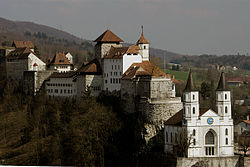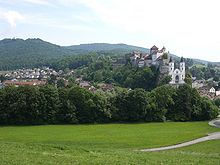
Aargau, more formally the Canton of Aargau, is one of the 26 cantons forming the Swiss Confederation. It is composed of eleven districts and its capital is Aarau.

The canton of Bern, or Berne, is one of the 26 cantons forming the Swiss Confederation. Its capital city, Bern, is also the de facto capital of Switzerland. The bear is the heraldic symbol of the canton, displayed on a red-yellow background.

Aarburg is a historic town and a municipality in the district of Zofingen in the canton of Aargau in Switzerland.

Lenzburg Castle is a castle located above the old part of the town of Lenzburg in the Canton of Aargau, Switzerland. It ranks among the oldest and most important of Switzerland. The castle stands on the almost circular castle hill, which rises approximately 100 m (330 ft) over the surrounding plain but is only about 250 m (820 ft) in diameter. The oldest parts of the castle date to the 11th century, when the Counts of Lenzburg built it as their seat. The castle, its historical museum and the castle hill with its Neolithic burial grounds are listed as heritage sites of national significance.

Brugg is a Swiss municipality and a town in the canton of Aargau and is the seat of the district of the same name. The town is located at the confluence of the Aare, Reuss, and Limmat, with the Aare flowing through its medieval part. It is located approximately 16 kilometers (9.9 mi) from the cantonal capital of Aarau; 28 kilometers (17 mi) from Zürich; and about 45 kilometers (28 mi) from Basel.

The city of Bern is one of the Zähringer foundations of the late 12th century. By the end of the 13th century, it had acquired de facto imperial immediacy. It became a full member of the Old Swiss Confederacy in 1353, and during the 15th century managed to significantly expand its sphere of influence, notably with the conquest of Aargau in 1415. With the acquisition of Vaud in 1536, Bern became the most powerful city-republic north of the Alps, and one of the leading Protestant cities in early modern Switzerland. The canton of Bern in the Restored Confederacy of 1815 even after the loss of Aargau and Vaud remained the largest Swiss canton, relegated to second rank only with the secession of Jura in 1979. Since 1848 Bern has served as the federal city (capital) of Switzerland.

Murgenthal is a municipality in the district of Zofingen in the canton of Aargau in Switzerland.

Oftringen is a municipality in the district of Zofingen in the canton of Aargau in Switzerland.

Rothrist is a municipality in the district of Zofingen in the canton of Aargau in Switzerland.
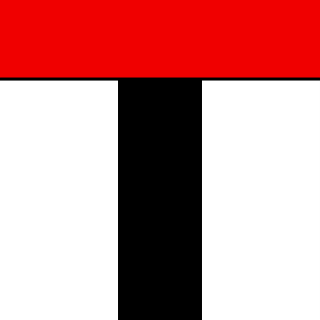
The County of Baden was a condominium of the Old Swiss Confederacy and is now part of the Swiss canton of Aargau. The county was established in 1415 after the Swiss conquest of the Aargau and was ruled as a shared condominium until 1798 when it became part of the short-lived Canton of Baden.

Schenkenberg Castle is a castle ruin above the municipality of Thalheim in the canton of Aargau in Switzerland. It was built in the 13th Century by the Habsburg dynasty, was the administrative seat for 260 years of a bailiwick of the city of Bern and fell into ruin in the 18th century.

Königsfelden Monastery is a former Franciscan double monastery, which housed both a community of Poor Clare nuns and one of Franciscan friars, living in separate wings, in the municipality of Windisch in the canton of Aargau in Switzerland. It was founded in 1308 by the Habsburgs. In the course of the Protestant Reformation in Switzerland in 1528 it was secularized, and the complex was then the residence of the bailiffs of Bern.
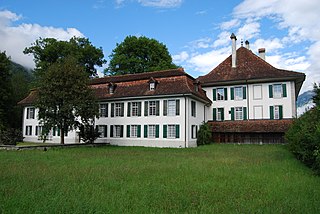
Interlaken Monastery was a convent of the Augustinian Canons Regular from about 1133 until 1528 at Interlaken in the canton of Bern in Switzerland. It is a Swiss heritage site of national significance.

The House of Frohburg was a noble family in medieval Switzerland, with possessions in what is now the canton of Solothurn. They originate in the Wigger basin, near Zofingen. In the 10th century, they built Frohburg Castle on a hill near Trimbach. They had the title of counts from the later 11th century. They ruled the lands between Olten and Solothurn, and took parts of Aargau and Sisgau as fief from the bishop of Basel. They reached the peak of their power in the later 12th and early 13th century, building a number of castles, and founding towns such as Aarburg, Liestal, Olten, Waldenburg, Wiedlisbach and Zofingen. They also founded Schöntal Abbey near Waldenburg. The House of Frohburg was divided into three branches, Neu-Homberg, Waldenburg and Zofingen, in c. 1250. The Zofingen branch was extinct in 1307, followed by the Neo-Homberg one in 1325. The Waldenburg branch survived for another 40 years but declined in influence, being forced to sell most of its possessions, most of them to the ascending House of Habsburg. The last count of Frohburg was Hermann VI.
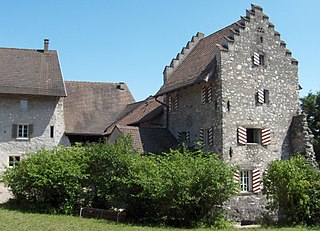
Altenburg Castle is a castle in the village of Altenburg bei Brugg in the municipality of Brugg in the canton of Aargau in Switzerland. The castle and the Altenburg Roman ruins, which are integrated into it, are classified as Swiss heritage site of national significance.

Liebegg Castle is a small castle in the municipality of Gränichen in the canton of Aargau in Switzerland. It is located on a outcropping about 70 meters (230 ft) above the Wynental valley floor. The current castle grew out of a medieval castle. A cantonal agricultural school opened in 1958 near the castle.

Trostburg Castle is a small castle in the municipality of Teufenthal in the canton of Aargau in Switzerland.
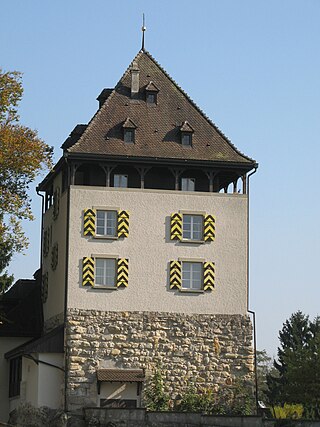
Auenstein Castle is a castle in the municipality of Auenstein in the Swiss canton of Aargau.
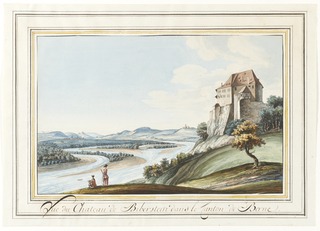
Biberstein Castle is a castle in the municipality of Biberstein in the Swiss canton of Aargau.
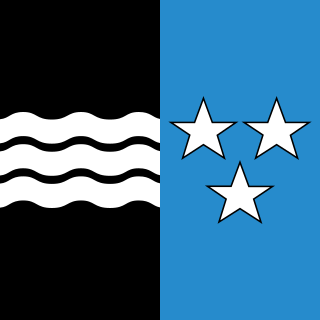
The History of the Canton of Aargau is dedicated to Aargau in Switzerland, founded in 1803, and its various preceding territories.
